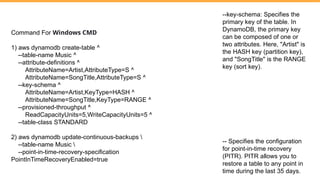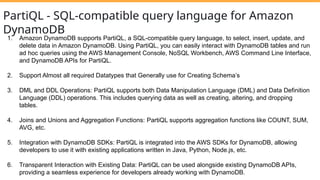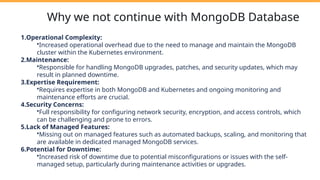DynamoDB Database Integration.pptx it's dynamodb databse related stufs
- 1. DynamoDB Database Integrate with Spring-boot
- 2. ● Amazon DynamoDB is a serverless, NoSQL, fully managed database service with single-digit millisecond response times at any scale, enabling to develop and run modern applications. ● It is a "schema-less" or "schema-flexible" database. the term "schema-less" means that don't need to define a fixed schema for data before storing it. We can insert and retrieve data without the need for a predefined table structure. ● What are ways to implement DynamoDB in Spring Boot Application 1. Combine Spring Data REST with Spring Data DynamoDB for RESTful endpoints. 2. Combine Spring Data JPA with DynamoDB Local for local development and testing. 3. Spring Cloud with AWS CloudFormation. What is DynamoDB
- 3. DynamoDB Database Setup With AWS 1. AWS Identity and Access Management (IAM) Select It Manage Access to AWS Resources 2. Create Particular Group and Create User 3. While Creating a new user add the group at that time using “Permission Option” 4. The creation of IAM groups and users, along with the assignment of users to groups, enhances security, simplifies administration, and promotes scalability and consistency in managing AWS resources and access. 5. Create Access Key In User Section Steps to Implement DynamoDB Database With AWS
- 4. 6. Review it Check Permission Summary 7. Create Database In DynamoDB 8. Setup Table name, Partition Key, Sort Key, with Required Data Types and Select Tables Settings. 9. Use the Required Properties like Access key Id, Secret Access Key in Sprint-Boot Configuration Class.
- 5. 1. Scalable NoSQL Database: DynamoDB is a fully managed NoSQL database service by AWS, designed for seamless scalability to handle varying workloads. 2. High Performance: Known for high performance and low-latency, DynamoDB is capable of handling millions of requests per second, making it suitable for applications with demanding performance needs. 3. Use Case for NoSQL: DynamoDB is an excellent choice for scenarios requiring a NoSQL database, such as applications dealing with unstructured or semi-structured data, rapid development cycles, and horizontal scaling. 4. Faster than Traditional Databases: DynamoDB's distributed architecture and optimized storage make it faster than traditional relational databases, especially for read and write-intensive workloads - especially for read and write-intensive workloads. For instance, in comparison to databases like MySQL or PostgreSQL, DynamoDB can exhibit superior performance due to its ability to horizontally scale and distribute data across multiple nodes seamlessly. This becomes particularly advantageous in scenarios where high throughput and low-latency access to data are critical requirements Introduction of DynamoDB with SpringBoot Application
- 6. 5. Key-Value and Document Store: DynamoDB's support for key-value and document data models provides developers with the flexibility to choose the most suitable approach based on the nature of the data application requirements. - Key-Value Store: Each item in the database is uniquely identified by a primary key, which can be a single attribute (simple key) or a combination of attributes (composite key). This key-value structure allows for fast and efficient retrieval of data based on the of data based on the unique identifier. - Document Store: DynamoDB goes beyond the traditional key-value paradigm by supporting complex data structures within each item. Items can contain nested attributes and arrays, essentially allowing DynamoDB to function as a This is particularly useful for scenarios where data is hierarchical or nested, such as JSON-like documents. 6. Supported Query Operations: DynamoDB supports a variety of query operations, including GetItem, PutItem, DeleteItem, and Query. Its flexible API allows efficient retrieval and manipulation of data. 7. Use Case for NoSQL: DynamoDB is an excellent choice for scenarios requiring a NoSQL database, such
- 7. There are several limitations For DynamoDB 1. Provisioned Throughput Constraints: DynamoDB requires you to provision read and write throughput capacity in advance. If your workload experiences unpredictable spikes or if you have varying traffic patterns, adjusting provisioned throughput might become challenging. 2. Item Size Limitation: Each item in a DynamoDB table has a size limitation of 400 KB. If your project deals with larger items, you may need to design the data model carefully or consider alternative storage solutions for larger objects. 3. Limited Indexing and Query Flexibility: DynamoDB allows for global and local secondary indexes, but their use is subject to certain limitations with constraints. Queries are based on primary key attributes and indexed attributes. Complex querying involving multiple attributes or complex conditions may require additional considerations or might be better suited for other database solutions. 4. No Support for Joins: DynamoDB does not support relational joins between tables. If your project requires complex relational data modeling and querying, a traditional relational database might be more suitable. 5. Limited Atomic Operations: DynamoDB supports atomic counters, but there are limitations on other atomic operations. If your project heavily relies on specific atomic operations, these limitations should be taken into account.
- 8. When connecting DynamoDB with a Spring Boot app, some difficulties may be face include: 1. Configuring the correct network settings between Spring Boot and DynamoDB: Need to ensure that the Spring Boot app can communicate with the DynamoDB Aws. 2. Signature expired: 20170517T062414Z is now earlier than 20170517T062840Z (20170517T063340Z - 5 min.) - Local Machine and AWS Console time Not Match 3. [Request processing failed: com.amazonaws.services.dynamodbv2.datamodeling.DynamoDBMappingExc eption: Employee; no mapping for HASH key] with root cause – Check Api Key, table name with Partition Key, Lombok, aws-java-sdk-dynamodb Version
- 9. Managed NoSQL Database: DynamoDB is a fully managed NoSQL database service provided by AWS. When we use DynamoDB with a Spring Boot application, for offload the operational overhead of managing and scaling the database to AWS. don't need to worry about tasks such as hardware provisioning, setup, configuration, replication, or software patching. Scalability and Performance: It automatically scales to handle varying workloads and can accommodate massive amounts of data and traffic. As your Spring Boot application grows, DynamoDB scales horizontally to handle increased read and write throughput. Why We Use DynamoDB And Integrate With AWS Integrated Development with Spring Data: Spring Data provides a unified and consistent programming model for data access in Spring applications, we can leverage Spring Data DynamoDB It allows you to use familiar Spring Data repository interfaces and annotations to perform CRUD (Create, Read, Update, Delete) operations on DynamoDB entities.
- 10. Streamlining the Development Process
- 11. ● DynamoDB Scalability and flexibility are key features that contribute to the significance of Amazon DynamoDB, a managed NoSQL database service offered by Amazon Web Services (AWS). Importance of Scalability and Flexibility 1. Scalability: As our application grows and our user base increases DynamoDB is designed to handle varying and unpredictable workloads. As the demand on your application grows or decreases, DynamoDB can automatically scale to adapt to changing needs. This elasticity ensures that your application remains responsive and performs well, even under varying levels of traffic. 2.Flexibility: DynamoDB's schema-less nature and flexibility in data modeling enable easy adaptation to evolving data structures. Developers can add or remove fields from items within a table without the need for a predefined schema. This flexibility is particularly valuable in scenarios where the data model is subject to change or when different items within the same table have distinct attributes. It allows for agile development and
- 13. DynamoDB Annotation Specific to AWS SDK For Java 1. @DynamoDBHashKey: This annotation is used to mark a field as the hash key for a DynamoDB table. In DynamoDB, each table must have a primary key, and it can be composed of one or two attributes: the hash key (mandatory) and the range key (optional). The hash key uniquely identifies an item in the table. 2. @DynamoDBAttribute: This annotation is used to mark a field as an attribute in the DynamoDB table. All fields that are persisted to DynamoDB must be annotated with @DynamoDBAttribute. 3. @DynamoDBDocument: Department Entity Class Assuming Department is another class, it is likely a nested or complex type. In DynamoDB, you can use the @DynamoDBDocument annotation to mark a field as a complex object, allowing you to store nested structures.
- 14. DynamoDB Query Language • Unlike Structured Query Language (SQL), DynamoDB queries use a Javascript Object Notation (JSON) format to structure its queries. • DynamoDB is a key-value NoSQL database. Primarily This makes it Amazon’s preferred database for simple and fast data models. • While DynamoDB models data in JSON format, allowing it to serve in document use cases Amazon recommends users to its Amazon Document DB, which is designed-for- purpose as a document store, and is also compatible with the widely-adopted MongoDB API. For example, DynamoDB doesn’t store data internally as JSON. It only uses JSON as a transport method. • Amazon DynamoDB doesn't store data internally as JSON. Instead, DynamoDB stores data in a binary format called "DynamoDB format" or "marshalled format." This format is proprietary and optimized for efficient storage and retrieval within the DynamoDB service.
- 15. Command For Windows CMD 1) aws dynamodb create-table ^ --table-name Music ^ --attribute-definitions ^ AttributeName=Artist,AttributeType=S ^ AttributeName=SongTitle,AttributeType=S ^ --key-schema ^ AttributeName=Artist,KeyType=HASH ^ AttributeName=SongTitle,KeyType=RANGE ^ --provisioned-throughput ^ ReadCapacityUnits=5,WriteCapacityUnits=5 ^ --table-class STANDARD 2) aws dynamodb update-continuous-backups --table-name Music --point-in-time-recovery-specification PointInTimeRecoveryEnabled=true --key-schema: Specifies the primary key of the table. In DynamoDB, the primary key can be composed of one or two attributes. Here, "Artist" is the HASH key (partition key), and "SongTitle" is the RANGE key (sort key). -- Specifies the configuration for point-in-time recovery (PITR). PITR allows you to restore a table to any point in time during the last 35 days.
- 16. MongoDB DynamoDB Source MongoDB is open-source and can be deployed anywhere in most clouds and/or on premises. DynamoDB is from the AWS ecosystem and can only be used within AWS. Management MongoDB can either be self-managed or fully managed with the MongoDB Atlas database as a service. DynamoDB is a fully managed solution. Amazon handles all server updates, patch updates, and hardware provisioning. Security Developers need to spend extra time upfront reconfiguring security on MongoDB, especially when self-managed. This is because it runs with defaults permitting unrestricted and direct access to data without authentication. MongoDB Atlas requires setup of authentication and network access via IP access controls or VPC peering. Security for DynamoDB starts out restrictive and incorporates with AWS IAM Policy infrastructure. Database structure MongoDB’s database structure is made of JSON-like documents comprising collections, keys, values, and documents. Documents can contain nested documents. DynamoDB’s database structure supports either blobs or documents as values.
- 17. Index use MongoDB supports up to 64 mutable indexes per collection, allowing the document’s structure to change dynamically. DynamoDB supports up to 20 mutable global indexes per table, which are not compatible with underlying data, and up to 5 local indexes which cannot be modified after table creation. Programming language MongoDB is written in C++ and supports programming languages like C, C++, Go, Java, JavaScript, PHP, Perl, Ruby, Python and more. DynamoDB supports programming languages like Java, JavaScript, Node.js, .NET, PHP and more. Data type and size restriction MongoDB supports various data types, and allows document sizes of up to 16MB. DynamoDB has limited support for data types, and allows item sizes of up to 400 KB. Industry use Companies use MongoDB for mobile apps and content management systems (CMSs). MongoDB is also excellent for scalability and caching. The gaming and Internet of things (IoT) industries widely use DynamoDB. Querying MongoDB has a rich query language. You can apply it in various ways: single keys, ranges, graph transversals, joins and more. DynamoDB’s querying is only available in local secondary indexes (LSI) and global secondary indexes (GSI).
- 18. PartiQL - SQL-compatible query language for Amazon DynamoDB 1. Amazon DynamoDB supports PartiQL, a SQL-compatible query language, to select, insert, update, and delete data in Amazon DynamoDB. Using PartiQL, you can easily interact with DynamoDB tables and run ad hoc queries using the AWS Management Console, NoSQL Workbench, AWS Command Line Interface, and DynamoDB APIs for PartiQL. 2. Support Almost all required Datatypes that Generally use for Creating Schema’s 3. DML and DDL Operations: PartiQL supports both Data Manipulation Language (DML) and Data Definition Language (DDL) operations. This includes querying data as well as creating, altering, and dropping tables. 4. Joins and Unions and Aggregation Functions: PartiQL supports aggregation functions like COUNT, SUM, AVG, etc. 5. Integration with DynamoDB SDKs: PartiQL is integrated into the AWS SDKs for DynamoDB, allowing developers to use it with existing applications written in Java, Python, Node.js, etc. 6. Transparent Interaction with Existing Data: PartiQL can be used alongside existing DynamoDB APIs, providing a seamless experience for developers already working with DynamoDB.
- 19. Why we not continue with MongoDB Database 1.Operational Complexity: •Increased operational overhead due to the need to manage and maintain the MongoDB cluster within the Kubernetes environment. 2.Maintenance: •Responsible for handling MongoDB upgrades, patches, and security updates, which may result in planned downtime. 3.Expertise Requirement: •Requires expertise in both MongoDB and Kubernetes and ongoing monitoring and maintenance efforts are crucial. 4.Security Concerns: •Full responsibility for configuring network security, encryption, and access controls, which can be challenging and prone to errors. 5.Lack of Managed Features: •Missing out on managed features such as automated backups, scaling, and monitoring that are available in dedicated managed MongoDB services. 6.Potential for Downtime: •Increased risk of downtime due to potential misconfigurations or issues with the self- managed setup, particularly during maintenance activities or upgrades.
- 20. • In conclusion, while self-hosting MongoDB in a Kubernetes cluster provides flexibility, it comes with increased complexity and operational responsibilities. Opting for a managed MongoDB service can alleviate these challenges, providing a more streamlined and reliable experience with built-in features and expert support. The choice ultimately depends on factors such as your team's expertise, resource availability, and the level of control and customization required for your MongoDB deployment. • Confluence Page
- 21. Global Secondary Indexes (GSIs) Enabling efficient retrieval of non-primary key data Cost implications and query pattern considerations DynamoDB Streams Near-instantaneous data ingestion and processing pipelines Eventual consistency vs. fine-grained control Transactions Atomic data consistency across tables or items Transaction Coordination API (TCA) vs. DynamoDB Streams Advanced Querying Complex queries over large datasets using expressions, filters, and conditions Advanced Topic







![When connecting DynamoDB with a Spring Boot app, some difficulties may be
face include:
1. Configuring the correct network settings between Spring Boot and
DynamoDB: Need to ensure that the Spring Boot app can communicate with
the DynamoDB Aws.
2. Signature expired: 20170517T062414Z is now earlier than 20170517T062840Z
(20170517T063340Z - 5 min.) - Local Machine and AWS Console time Not
Match
3. [Request processing failed:
com.amazonaws.services.dynamodbv2.datamodeling.DynamoDBMappingExc
eption: Employee; no mapping for HASH key] with root cause – Check Api Key,
table name with Partition Key, Lombok, aws-java-sdk-dynamodb Version](https://image.slidesharecdn.com/dynamodbdatabaseintegration-250417190000-ff25eba3/85/DynamoDB-Database-Integration-pptx-it-s-dynamodb-databse-related-stufs-8-320.jpg)













